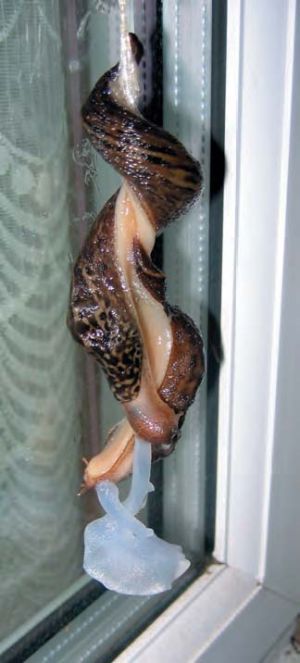|
Where is the best place to see Limax maximus mating? We were treated to the spectacle several times this summer and are interested to know if other readers share our experience. Unfortunately, recording the behaviour seemed to require some ASBO-baiting loitering in residential areas after dark. The housing in central Cardiff consists largely of late 19th century terraces with small front gardens and rough stone walls that harbour big populations of slugs, particularly L. maximus, L. flavus and Arion ater. They emerge at night throughout the year to feed on the dogfouled pavements, apparently staying hidden on only the coldest nights. Most of the gardens are paved, overgrown with valerian and dandelions or full of broken furniture (civic pride apparently not widespread among local landlords or tenants). There is thus an absence of trees or fences from which mating L. maximus can hang, but as we discovered they are perfectly able to manage with the front walls and even window panes. This makes them easy to spot between 22.00 and 1.00 at night in late summer, when we made most of our observations. We saw one window pane used one night per week three weeks in a row, by what appeared to be different individuals. In another street we saw no less than 6 mating pairs in one night (5 September). This would have offered ideal photography or filming opportunities - had we had a camera. While watching these pairings we noticed some extravagant tailslapping behaviour. One slug would follow another and occasionally receive a vigorous slap across the tentacles or face by the tail of the first. Some slugs received two or three slaps in succession so were evidently not always deterred by the first. At other times, the following slug seemed to land a successful bite on the tail. As with parts of the mating process, the slugs seemed unusually fast-moving and energetic during these behaviours. However, it is not clear whether it was part of the courtship and mating process (which has been fairly well-described by Taylor and others) or an aggressive territorial behaviour. We saw slugs that had just mated slapping others that had not, (at least in the last hour or two). A mated slug whose path crossed that of a third individual also received a slap. We did not see slapping between slugs that immediately went on to mate, however. We know that tail-slapping is a feature of courtship or mating in some Deroceras spp. and that the mating of L. maximus is well-described, but could not find a reference to tail-slapping in this species. Perhaps the slapping behaviour also occurs on other occasions when these territorial slugs come into contact. In the same area we have seen L. maximus chasing and repeatedly biting Arion ater (on the tail, inevitably) as they try to escape, in what we presume was defence of territory. We were also struck by the apparent ease and speed with which mating slugs produced their mucus strings. We did not see partners circle repeatedly around one another, a process that Taylor describes as taking up to two and a half hours “or more” in L. maximus. Instead, mating pairs remained in a vertical line with the head of one partner touching the tail of the other. They remained still for 10-15 minutes while they secreted enough mucus to attach the top of the string, the mucus perhaps coming from the head or tail mucus glands of either or both partners. The slugs then twisted once over one another and began descending the string, the genitalia being everted soon after. At the end of all the matings we observed, one slug moved away from the bottom end of the string while the other climbed it, although it was not seen biting or eating the string. Other slugs were seen feeding on the remains of mucus strings, but these may have been the result of other matings. In the absence of rain, strings may last for two or three nights and can be found during the daytime. Next summer we hope to obtain some better video of the process, record some more detailed data, and to see whether individuals can be identified as being involved in more than one pairing. Perhaps a better knowledge of the mating system of this species will shed light on the range of extraordinary behaviours. |
Fig 1 (Photo Ben Rowson) |
Happy slapping slugs
Issue
9
Page
11
Species

